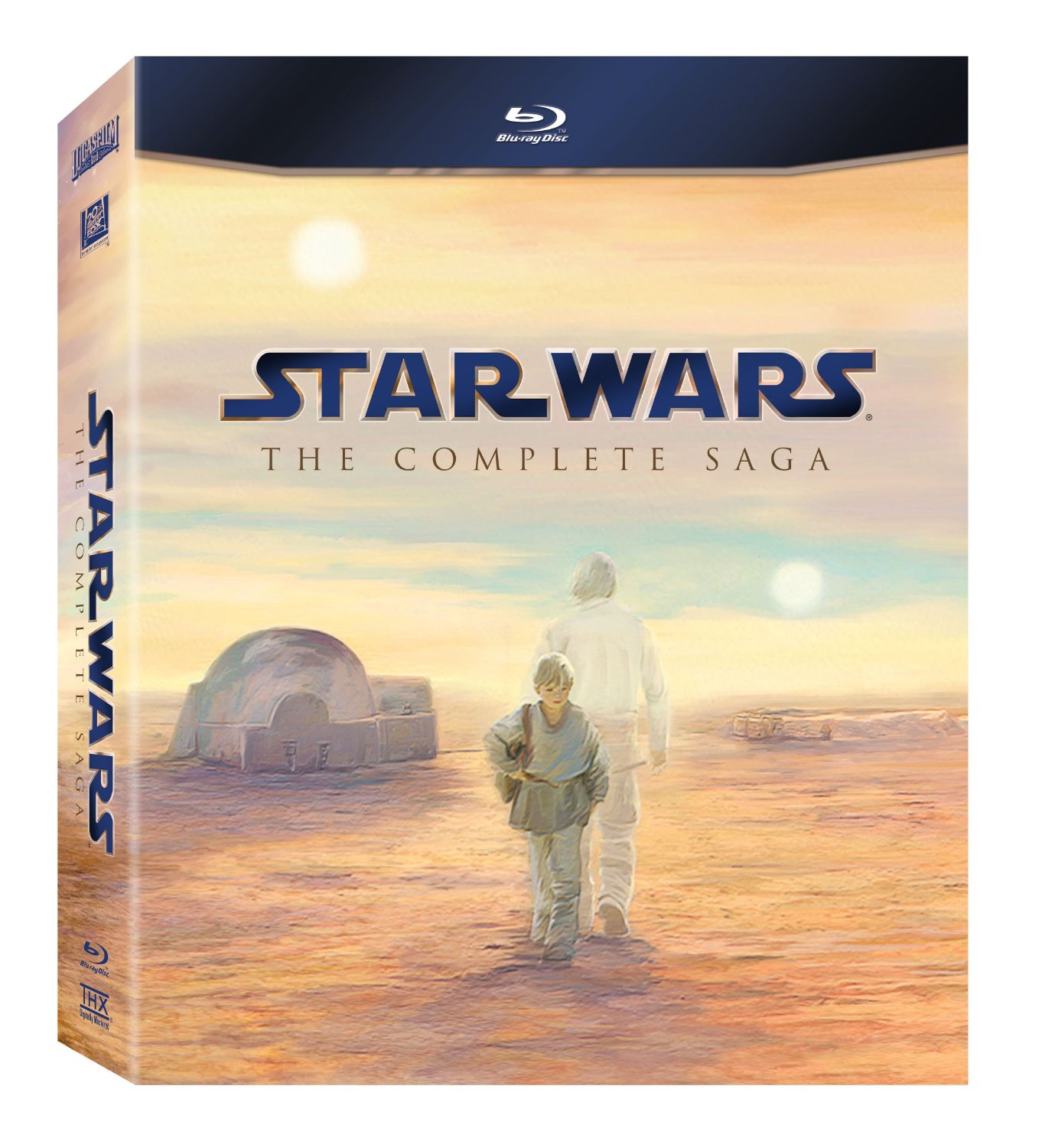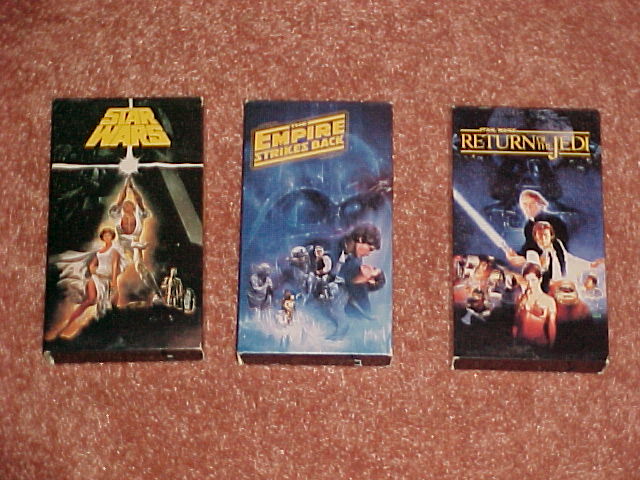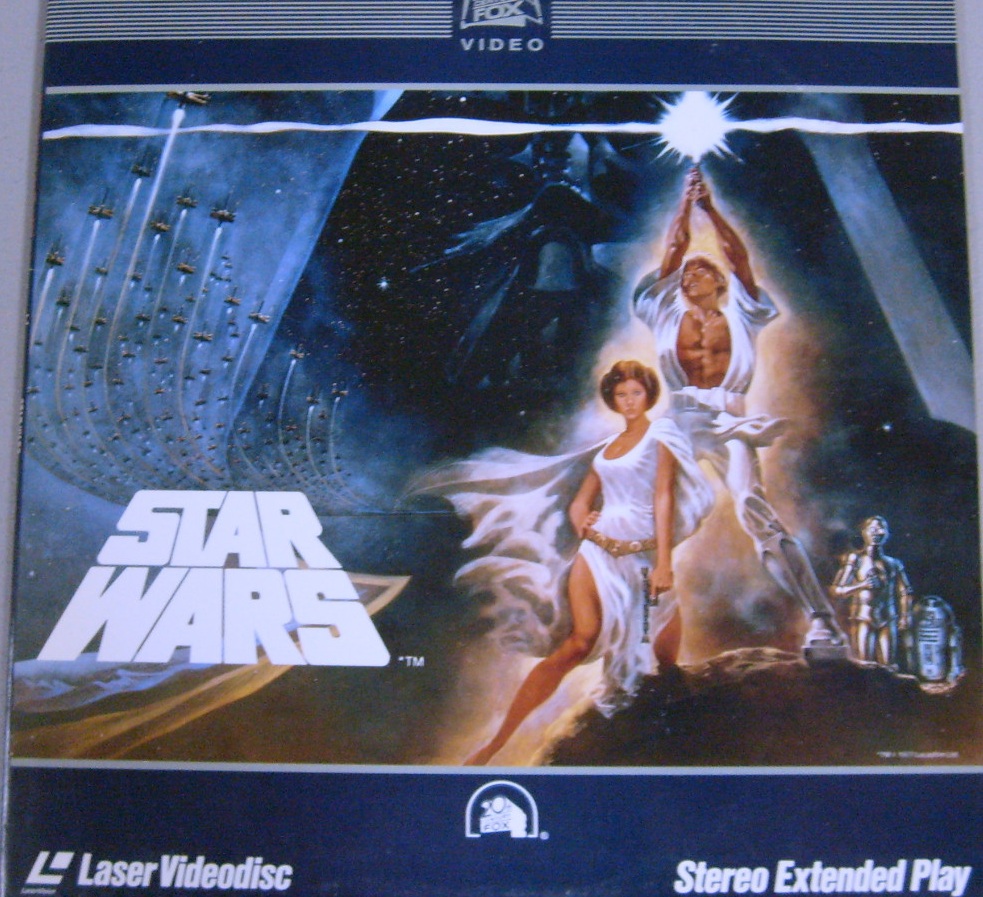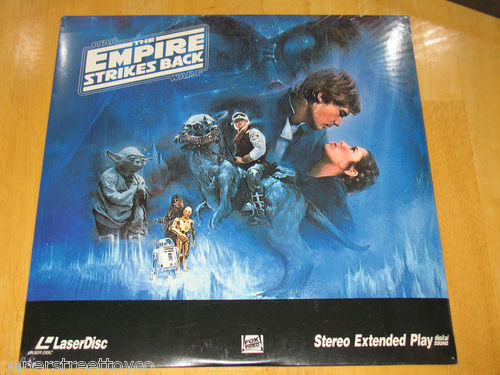I am not a big fan of Star Wars. While I did see the original trilogy in the theatres when they were originally released, I waited for home video to see the first two of the new trilogy. I did go to the theatre for the last one, I was anxious to see Hayden Christenson turn into James Earl Jones.
But since the beginning, Star Wars has always been a prompter, or at least a marker, for home theatre, especially my home theater. So I thought it would be proper and fun to report of these movies in this context. 
Star Wars: The Complete Saga (Episodes I-VI) [Blu-ray]
It can be said that Home Theatre began in the 1950s, when Castle Films released edited versions of famous films (Abbott and Costello Meet Frankenstein, This Island Earth and many others) on 8mm and later 16mm, some even with sound. But let us concern ourselves with the electronic age.
The first step to home theatre was the Betamax VCR in the mid 1970s. However, VCRS did not catch on until 1984 when the Supreme Court ruled, 5-4, that VCR were legal, especially the record function. Then sales really took off and the prices of VCR dropped from $1,000 to as low $200 when the competitor, VHS was introduced and eventually won the “format” war.
Movies on tape were new and it took a bit of time for the market to develop. There were a few stores and prices of new tapes were $80-100, ($150-200 in today’s money.) Blank tapes sold for $20. The movie studios did not want rentals. This too was a court. When this case was resolved, local video stores flourished and then the big guys stepped in. It was, however, not like it is today. Tapes came out erratically for the first few years. New movies often took a year or more to be released on tape.
If you got your Star Wars tape on Beta, about 1981, it was monaural; the VHS tape was two channel stereo. There was no surround sound and the movies were not wide screen, they were “panned and scanned”. By today’s standards they looked and sounded poorly. But you were finally able to take a movie home and watch it when you wanted.
Believe it or not, there were MANY articles in newspapers and magazine, saying way home video would fail. The authors felt that although we liked to listen to music over and over again, people would NOT want to see movies again. No one who had a child and the Wizard of Oz believed that! Kids loved to see movies again and again and so did adults. You never hear that reasoning anymore!
In 1981 video discs made it to market with two competing products. RCA sponsored a video disc system that actually played like a record. It was originally monaural. It wasn’t really good and was discontinued in a few years when video laser discs were also released. Their picture was outstanding for those days. The two channel stereo sound, originally “analog” was updated to “digital” (meaning CD quality) years later and they sounded great. Remember, laser discs came out years BEFORE CDs.
Laser disc releases were not linked to the VCR tape releases, so you usually had to wait even longer than a year. It took until the early 1990s for lasers to be “day and date” with the VCR tapes. By that time beta was basically gone.
When the first Star War video discs came out, about the mid 1980s, they were pan and scan and in stereo. They were released in both the RCA and laser disc formats and were in two channel stereo.
In 1985, I moved to a bigger apartment and was able, for the first time, to put my TV set in-between my speakers. At this time, the FCC was pressuring broadcast TV stations air their programs in stereo. Running he laser disc and TV sound through my stereo certainly gave me better sound than I ever had before. I loved it.
I then bought my first surround sound processor. Unlike today’s units, this was not a preamp, nor did it have digital sound. That was had not been invented yet. In the beginning, two channel sound was the basis for surround sound, not the 5.1 discrete channels that we have today. I had no center channel, but there was an illusion of what is often called the “phantom center.” You could get a center but at this time I didn’t and saw no need for it, it sounded fine. This also was not “discrete” surround, meaning that there were NOT four separate tracks. The stereo tracks feed “out of phase” sound to the rear. It sound great at the time, but again, by today’s standards it would be lacking.
It was great watching Star Wars on disc, but it was also fun to watch, and listen to, Star Trek: The Next Generation in stereo and on TV.
The next version of Star Wars was released on Laser in 1989 and this was a big deal. It was still in just stereo, there were no THX yet either, but this was the widescreen (letterboxed) version of the movies. This was great. I wanted a TV with a larger screen! I went form a 25 incher to a 32. The better the surround, the larger I wanted my screen.
Then George Lucas introduced THX. Lucas was a leader in better Movie Theatre and Home Theatre sound. He set the standard with THX. In the beginning every disc had its own equalization” with very different sound and bass levels. This often meant that when you put on a disc you spent the first five minutes adjusting the sound levels. Of the very few homes that had surround then most did NOT have a center speaker. The THX movement solved a lot of that. They had a standard for equalization for every disc. And, this meant that you would really need to get a center channel or you would never hear the dialogue. As time went by, even non-THX discs began to have similar sound levels. THX was a big help.
For a while, it seemed much of the consumer products, speakers, sub-woofers, disc players and receivers had THX certification all over them! It was a big selling point. Many people, however, did not yet understand that THX was primarily for MOVIES and their music, if played by the same system, might not sound as good as it should.
Lucas released “Star Wars” the Definitive Edition on Laser in 1993. This set of the first three Stars Wars Movies was then and is now the best representation of the ORIGINAL movies. It also came with a big book about Star Wars. This was the first release of the Stars Wars movies in THX, but it was still two channel sound, no Dolby Digital. The picture quality was also improved.
The laser disc player was now connected directly to a newer surround sound unit, one with new digital two channel inputs. It used a new wire called a “Toslink.” Now that virtually all discs were either THX or something close, I got a center channel and it sounded, well great. Star Wars was just impressive. Till this day nothing really has given me more pleasure than that the Proceed set up. I even got a sub-woofer and felt the room shake when I played the discs.
Some people thought that 5.1 SOUND WAS ALWAYS BETTER. However, the two channel sound was far less compressed and while it did NOT give you direction it often, in the beginning, and with those Star Wars discs, give a fuller, thicker, sound that Dolby Digital. That would change, slowly, as Dolby and, later DTS, a Dolby competitor that was less compressed, got better.
Over the next few years Lucas shot new footage and reedited the first Trilogy and released them on Laser in 1997. There were booklets inside that explained the changes. I never minded the changes, and Lucas certainly brought Star Wars: A New Hope up to the technical standards of the last two.
Can we now have a moment of silence for the death of the Laser Disc?
It took the CD player about five years to make the phonograph an antique. It took, maybe two years, for it to replace the cassette tape. Laser did not go out without a fight. They released laser players and discs with 5.1 outputs and DTS sound (which did sound incredible) and even machines that played both Lasers and DVDs. But DVDs cost about 1/3 as much and were available everywhere; they were smaller and easier to store and they mostly looked better on the TV screen. The DVD players played CD, so a lot people bought them for both. I think it took the DVD about six months to replace the laser disc and, unlike vinyl, no one looked back.
To make everything sound better (not look better) I got a front projection system so I would not have a big TV between my speakers and behind a center channel.
So in 2004, eight years after the last release on disc, Star Wars came out on DVD, followed by the new trilogy editions. They looked and sound great. But, I did miss that “thicker” laser sound.
Now, let us talk about the movies. First the original Trilogy
I enjoyed the original trilogy. I did not mind the new edits that appeared on the DVD. They aligned the movies up better than before. Even Tolkien went back after he finished Lord of the Rings to rewrite part of The Hobbit. Star Wars actually set the stage for a great second act, “The Empire Strikes Back” the best of the series. Here, the heroes don’t win. Ian McDiarmid would play the evil Emperor in the next four movies. Lucas went back and placed him in the DVD of Empire and it works well. Also, Lucas edited the conclusion of “Return of the Jedi” to make the last scenes, of the Emperor, Luke and Darth Vader make a lot more sense and have a greater emotional reaction.
Review of the last Trilogy
If you are looking for great images, great special effects and great sound the last trilogy is for you. But not for me. Gone were the characterizations, plot, humor and fun of the first three movies. They were replaced by long special effects scenes and corny, incomprehensible dialogue. And there was so much potential here. The special effects actually became a distraction in these three movies, diverted the cast and director attention away from making a movie that could connect with viewers like the first trilogy.
In watching The Phantom Menace I am wondering, who is Anakin’s father? Why don’t they tell us? It would have been great, even clever, to make it the Emperor. Instead, we are given a “virgin” birth? He’s supposed to be Christ? Although they leave a door open here, they never go through it. In Episode III, Revenge of the Sith the Emperor actually explains to Anakin a possible resolution to this, but it doesn’t go far enough to connect any of the dots. And the child is just too young. Jake Lloyd was ten years old, Natalie Portman was twenty. It was a total mismatch and simply didn’t work. And the end of the movie major plot points were resolved just by serendipity, luck, and made little sense. But they were loud and action packed.
Of course Anakin grew up unbelievably quickly in the second movie. Anakin, now played by Hayden Christenson is now the same age as Ms. Portman, but that didn’t make sense. Any scenes, as poorly written as they were, that showed any real development or chemistry in their relationship, were cut out. (And put into the deleted scenes segment.) I wanted to know why it took ten years for Anakin to try to free his mother but that issue never comes up. Actually it is probably because they cast Anakin too young in the first place. This story should have taken place a couple years after The Phantom Menace, but they had to place it ten years in the future to show Anakin’s growth. Lawrence Kasdan was a writer in the original Trilogy (and Raiders) and he could develop relations. On his own Lucas couldn’t do writing and directng and kept substituting long battle scenes for plot development. That began to get boring. Another example is when Jango Fett is killed, we see his son Boba Fett’s reaction, but there is no follow-up to what happens to the now-fatherless boy.
Of course the final movie, The Revenge of the Sith opens with long action sequences. The movies take up over 6 hours and then Lucas decides to give us about 20 minutes to align these movies with Star Wars: A New Hope. Padme has been pregnant for about four months, but is now ready to deliver. You see her in a mini-skirt and small baby bump running off of a spaceship and in a couple of hours gives birth to twins! She has a quick, bloodless birth, but is healthy enough to name the kids (where did the names come from?) and then, as a new mother, “loses the will to live” and just dies! Huh? Why does she die? Even the doctor is not human, it is a robot. This is another example of how this series has totally lost its humanity. Yoda and Obi Wan go into exile, why? And Obi Wan says he will look after Luke, when, if he saw the first picture, he doesn’t. Oh, the highlight really is that marvelous voice of James Earl Jones. Anyone could have Darth Vader in the climactic scene, but Christianson insisted on doing it. We hear the breathing, we hear the anguish, but it is too little, seven hours too late.
Sometimes the difference between Blu-Ray and DVD can be startling. It is so here. The details and color is amazing and, frankly, is better than some movie theatres. The sound in my home has been better than most theatres for years, except when I see an Imax picture. It is popular to say that Star Wars began the push for much better picture and sound. This is kind of true. You see, the better picture and sound really begins, on DVD and especially on Blu Ray with the Empire Strikes Back. So while the video on all the discs are great, it’s better on the later movies
Audio and Video
This is hard to do. That is, compared to any other movie, the audio and video here are unanimously 5 out of 5. But compared to each other, it actually gets better so:
Star Wars:
Video: 4.75 out of 5
Audio: 4.75 out of 5
Really excellent, but the next two movies are even better.
Empire and Jedi:
Video: 4.99 out of 5
Audio: 4.99 out of 5
Excellent. The sound is far better here than on Star Wars, the picture is great too, but he next three pictures are just incredible.
The Entire Second Trilogy:
Video: 5.0 out of 5
Audio: 5.0 out of 5
The video is incredible and the audio is even a bit overwhelming. I began to turn down the sound! A major difference is the use of the rear (not surround) channels. This will sound wonderful on a 6.1, 7.1, system
The Blu-Ray set also contains several interesting documentaries from previous editions: The Making of Star Wars (49 Minutes); The Empire Strikes Back: The Special Effects (l48 Minutes) and Return of the Jedi: Classic Creatures (48 Minutes).
There are two new documentaries, “Star Warriors” (84 minutes) and “A Conversation with the Masters: The Empire Strikes Back 30 Years Later” (2010, 25 Minutes). As previously mentioned there are deleted, extended and alternate scenes and even more interviews with the cast and crew.
But the best is a 90 feature of Star Wars spoofs, from The Simpsons to Saturday Night live. Watch this is a least two segments, it’s a lot of fun and a lot of laughs.




For the saga to be truly complete, one question remains: did they finally include The Star Wars Holiday Special in this edition?
Nope. There is no Ewok special either.